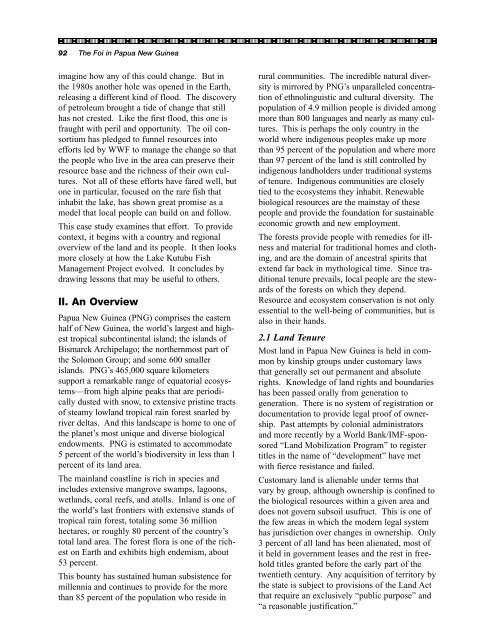Indigenous Peoples and Conservation Organizations
Indigenous Peoples and Conservation Organizations
Indigenous Peoples and Conservation Organizations
You also want an ePaper? Increase the reach of your titles
YUMPU automatically turns print PDFs into web optimized ePapers that Google loves.
92 The Foi in Papua New Guinea<br />
imagine how any of this could change. But in<br />
the 1980s another hole was opened in the Earth,<br />
releasing a different kind of flood. The discovery<br />
of petroleum brought a tide of change that still<br />
has not crested. Like the first flood, this one is<br />
fraught with peril <strong>and</strong> opportunity. The oil consortium<br />
has pledged to funnel resources into<br />
efforts led by WWF to manage the change so that<br />
the people who live in the area can preserve their<br />
resource base <strong>and</strong> the richness of their own cultures.<br />
Not all of these efforts have fared well, but<br />
one in particular, focused on the rare fish that<br />
inhabit the lake, has shown great promise as a<br />
model that local people can build on <strong>and</strong> follow.<br />
This case study examines that effort. To provide<br />
context, it begins with a country <strong>and</strong> regional<br />
overview of the l<strong>and</strong> <strong>and</strong> its people. It then looks<br />
more closely at how the Lake Kutubu Fish<br />
Management Project evolved. It concludes by<br />
drawing lessons that may be useful to others.<br />
II. An Overview<br />
Papua New Guinea (PNG) comprises the eastern<br />
half of New Guinea, the world’s largest <strong>and</strong> highest<br />
tropical subcontinental isl<strong>and</strong>; the isl<strong>and</strong>s of<br />
Bismarck Archipelago; the northernmost part of<br />
the Solomon Group; <strong>and</strong> some 600 smaller<br />
isl<strong>and</strong>s. PNG’s 465,000 square kilometers<br />
support a remarkable range of equatorial ecosystems—from<br />
high alpine peaks that are periodically<br />
dusted with snow, to extensive pristine tracts<br />
of steamy lowl<strong>and</strong> tropical rain forest snarled by<br />
river deltas. And this l<strong>and</strong>scape is home to one of<br />
the planet’s most unique <strong>and</strong> diverse biological<br />
endowments. PNG is estimated to accommodate<br />
5 percent of the world’s biodiversity in less than 1<br />
percent of its l<strong>and</strong> area.<br />
The mainl<strong>and</strong> coastline is rich in species <strong>and</strong><br />
includes extensive mangrove swamps, lagoons,<br />
wetl<strong>and</strong>s, coral reefs, <strong>and</strong> atolls. Inl<strong>and</strong> is one of<br />
the world’s last frontiers with extensive st<strong>and</strong>s of<br />
tropical rain forest, totaling some 36 million<br />
hectares, or roughly 80 percent of the country’s<br />
total l<strong>and</strong> area. The forest flora is one of the richest<br />
on Earth <strong>and</strong> exhibits high endemism, about<br />
53 percent.<br />
This bounty has sustained human subsistence for<br />
millennia <strong>and</strong> continues to provide for the more<br />
than 85 percent of the population who reside in<br />
rural communities. The incredible natural diversity<br />
is mirrored by PNG’s unparalleled concentration<br />
of ethnolinguistic <strong>and</strong> cultural diversity. The<br />
population of 4.9 million people is divided among<br />
more than 800 languages <strong>and</strong> nearly as many cultures.<br />
This is perhaps the only country in the<br />
world where indigenous peoples make up more<br />
than 95 percent of the population <strong>and</strong> where more<br />
than 97 percent of the l<strong>and</strong> is still controlled by<br />
indigenous l<strong>and</strong>holders under traditional systems<br />
of tenure. <strong>Indigenous</strong> communities are closely<br />
tied to the ecosystems they inhabit. Renewable<br />
biological resources are the mainstay of these<br />
people <strong>and</strong> provide the foundation for sustainable<br />
economic growth <strong>and</strong> new employment.<br />
The forests provide people with remedies for illness<br />
<strong>and</strong> material for traditional homes <strong>and</strong> clothing,<br />
<strong>and</strong> are the domain of ancestral spirits that<br />
extend far back in mythological time. Since traditional<br />
tenure prevails, local people are the stewards<br />
of the forests on which they depend.<br />
Resource <strong>and</strong> ecosystem conservation is not only<br />
essential to the well-being of communities, but is<br />
also in their h<strong>and</strong>s.<br />
2.1 L<strong>and</strong> Tenure<br />
Most l<strong>and</strong> in Papua New Guinea is held in common<br />
by kinship groups under customary laws<br />
that generally set out permanent <strong>and</strong> absolute<br />
rights. Knowledge of l<strong>and</strong> rights <strong>and</strong> boundaries<br />
has been passed orally from generation to<br />
generation. There is no system of registration or<br />
documentation to provide legal proof of ownership.<br />
Past attempts by colonial administrators<br />
<strong>and</strong> more recently by a World Bank/IMF-sponsored<br />
“L<strong>and</strong> Mobilization Program” to register<br />
titles in the name of “development” have met<br />
with fierce resistance <strong>and</strong> failed.<br />
Customary l<strong>and</strong> is alienable under terms that<br />
vary by group, although ownership is confined to<br />
the biological resources within a given area <strong>and</strong><br />
does not govern subsoil usufruct. This is one of<br />
the few areas in which the modern legal system<br />
has jurisdiction over changes in ownership. Only<br />
3 percent of all l<strong>and</strong> has been alienated, most of<br />
it held in government leases <strong>and</strong> the rest in freehold<br />
titles granted before the early part of the<br />
twentieth century. Any acquisition of territory by<br />
the state is subject to provisions of the L<strong>and</strong> Act<br />
that require an exclusively “public purpose” <strong>and</strong><br />
“a reasonable justification.”

















